titanic

 Born in Uruguay 1840, Ramon Artagaveytia was an Argentinian businessman. Even in 1840, businessmen had a need to travel periodically. That is why Artagaveytia found himself on board the ship America when it sank in December 1871. I’m sure the situation was absolutely terrifying, but Artagaveytia, became one of just 65 passengers to survive the disaster. He survived, only by jumping into the water and swimming to safety. I’m sure he felt very fortunate to survive his ordeal, but that is not to say that he was not traumatized. For years, Ramon Artagaveytia, was terrified of travel. Still, while he may have limited his travel, it was still essential at times.
Born in Uruguay 1840, Ramon Artagaveytia was an Argentinian businessman. Even in 1840, businessmen had a need to travel periodically. That is why Artagaveytia found himself on board the ship America when it sank in December 1871. I’m sure the situation was absolutely terrifying, but Artagaveytia, became one of just 65 passengers to survive the disaster. He survived, only by jumping into the water and swimming to safety. I’m sure he felt very fortunate to survive his ordeal, but that is not to say that he was not traumatized. For years, Ramon Artagaveytia, was terrified of travel. Still, while he may have limited his travel, it was still essential at times.
All that changed in 1912, when he wrote a letter to one of his cousins. In his letter, Artagaveytia, expressed relief, saying, “At last I will be able to travel, and, above all, I will be able to sleep calm. The sinking of the America was terrible!… Nightmares keep tormenting me. Even in the most quiet trips, I wake up in the middle of the night with terrible nightmares and always hearing the same fateful word: ‘Fire! Fire! Fire!’… I have even gotten to the point where I find myself standing in the deck with my lifebelt on….”
Artagaveytia was returning to the Americas, following a visit with his nephew in Berlin. As it turned out, the ship that finally put his mind at ease, was the “unsinkable” Titanic. When Artagaveytia arrived at Titanic, he was awed by its luxury. Everyone who saw Titanic was awed by its luxury. For Artagaveytia, one of Titanic’s greatest features was the fact that the ship had telegram capabilities. The promise of instant communication should a crisis arise, brought Artagaveytia great comfort.
Of course, as we all now know, Titanic would not be the ship that would make him safe. Titanic was simply not “unsinkable” because no ship is unsinkable. Titanic would hit that iceberg hiding in the darkness on April 14, 1912, and it would sink, in the early hours of April 15, 1912. Artagaveytia was reportedly seen on one of the decks of Titanic with two fellow passengers, looking as though he wasn’t concerned about the ship actually 
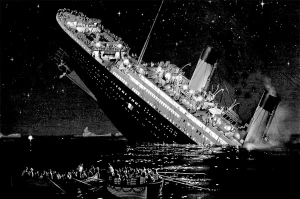 sinking. He had accepted the story that so many people had believed…that somehow, this ship was “unsinkable.” Somehow, he and many others trusted the story above what should have been understood a known fact…that any ship can sink. This time, Artagaveytia would not escape. Artagaveytia’s body was found in the North Atlantic roughly one week after the ship sank to the bottom of the sea.
sinking. He had accepted the story that so many people had believed…that somehow, this ship was “unsinkable.” Somehow, he and many others trusted the story above what should have been understood a known fact…that any ship can sink. This time, Artagaveytia would not escape. Artagaveytia’s body was found in the North Atlantic roughly one week after the ship sank to the bottom of the sea.

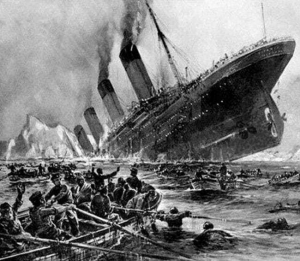 Following the Titanic disaster, a strange kind of job was formed…that of an iceberg mover. This was something I had never heard of, and it seems rather strange. I am aware that icebergs are chucks of ice, and obviously that they float, but to have the job of actually keeping track of an iceberg’s location so that you can go out to move it out of the shipping lanes is a really odd job, if you ask me. Still, the icebergs floating in the oceans, were a serious danger to the ships. Even if other ships were in the area and had seen the icebergs, that doesn’t mean other ships couldn’t fall prey to the icebergs. Many of those ships shut down their radios overnight…the most dangerous time for icebergs.
Following the Titanic disaster, a strange kind of job was formed…that of an iceberg mover. This was something I had never heard of, and it seems rather strange. I am aware that icebergs are chucks of ice, and obviously that they float, but to have the job of actually keeping track of an iceberg’s location so that you can go out to move it out of the shipping lanes is a really odd job, if you ask me. Still, the icebergs floating in the oceans, were a serious danger to the ships. Even if other ships were in the area and had seen the icebergs, that doesn’t mean other ships couldn’t fall prey to the icebergs. Many of those ships shut down their radios overnight…the most dangerous time for icebergs.
The job of the iceberg movers was to keep track of the icebergs and if they moved into the shipping lanes, to go in and move them to a different location. Now, that makes me wonder how heavy the icebergs were, and how hard it would be to move them. I also wonder how dangerous it would be, since icebergs have an uncanny knack for flipping over. Of course, iceberg movers are in a boat. Still, it’s hard to say what things can go wrong when an iceberg flips over. I really don’t think this would be a job I would want.
It seems like they might have had trouble hiring people to do this job, or maybe they just needed a more stable crew of men for the job. Whatever the case may be, The International Ice Patrol (IIP), was founded a year later. The IIP is operated by the US Coast Guard. The IIP tracks the location of icebergs and provides safe routes around them. If an iceberg is in a particularly unsafe area, it might become necessary to move it. Then, the iceberg will be towed out of the area. There is no way that they will be able to stop shipwrecks from 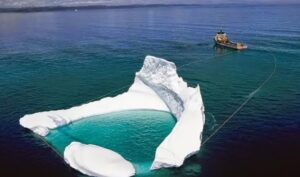
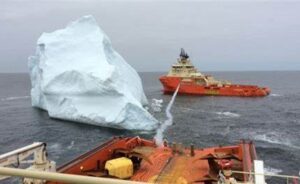 happening, but if we can remove the dangers created by icebergs, maybe we will see a few less shipwrecks in the future. Since Titanic, there have been five ship that went down after hitting an iceberg. Lives were lost in the first two following Titanic, but in the last three, everyone was saved. The last one was in 2007.
happening, but if we can remove the dangers created by icebergs, maybe we will see a few less shipwrecks in the future. Since Titanic, there have been five ship that went down after hitting an iceberg. Lives were lost in the first two following Titanic, but in the last three, everyone was saved. The last one was in 2007.
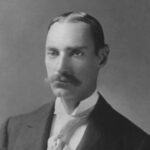
 John Jacob Astor IV was born on July 13, 1864 at his parents’ country estate of Ferncliff in Rhinebeck, New York. He was the youngest of five children and only son of William Backhouse Astor Jr, a businessman, collector, and racehorse breeder/owner, and Caroline Webster “Lina” Schermerhorn, a Dutch-American socialite. His four elder sisters were Emily, Helen, Charlotte, and Caroline (“Carrie”). John Astor IV was an American business magnate, real estate developer, investor, writer, lieutenant colonel in the Spanish–American War. He came from a long line of the very prominent Astor family.
John Jacob Astor IV was born on July 13, 1864 at his parents’ country estate of Ferncliff in Rhinebeck, New York. He was the youngest of five children and only son of William Backhouse Astor Jr, a businessman, collector, and racehorse breeder/owner, and Caroline Webster “Lina” Schermerhorn, a Dutch-American socialite. His four elder sisters were Emily, Helen, Charlotte, and Caroline (“Carrie”). John Astor IV was an American business magnate, real estate developer, investor, writer, lieutenant colonel in the Spanish–American War. He came from a long line of the very prominent Astor family.
Astor’s was an accomplished writer, having published “A Journey in Other Worlds” (1894), a science-fiction novel about life in the year 2000 on the planets Saturn and Jupiter. He was also an inventor. He patented several inventions, including a bicycle brake in 1898, a “vibratory disintegrator” used to produce gas from peat moss, and a pneumatic road-improver, and he helped develop a turbine engine. He was a great visionary, and his contributions to the world were amazing. 
Astor married socialite Ava Lowle Willing on February 17, 1891. The couple had two children, William Vincent Astor (November 15, 1891 – February 3, 1959), businessman and philanthropist, and Ava Alice Muriel Astor (July 7, 1902 – July 19, 1956). The couple divorced in November 1909. Astor IV remarried shortly thereafter, compounding the scandal of his divorce. At the age of 47, Astor married 18-year-old socialite Madeleine Talmage Force, the sister of real estate businesswoman and socialite Katherine Emmons Force. Astor and Force were married in his mother’s ballroom at Beechwood, the family’s Newport, Rhode Island, mansion. There was also much controversy over their 29-year age difference. His son Vincent despised Force, yet he served as best man at his father’s wedding. The couple took an extended honeymoon in Europe and Egypt to wait for the gossip to calm down. Among the few Americans who did not spurn him at this time was Margaret Brown, later fictionalized as The Unsinkable Molly Brown. She accompanied the Astors to Egypt and France. After receiving a call to return to the United States, Brown accompanied the couple back home aboard RMS Titanic.
Astor IV died in the sinking of the RMS Titanic during the early hours of April 15, 1912. Astor was the richest passenger aboard the RMS Titanic and was thought to be among the richest people in the world at that time. He was also a true gentleman, who would never have been on a lifeboat without knowing that all the women and children were on lifeboats. Astor IV had a net worth of roughly $87 million when he died, which would be 
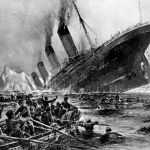 equivalent to $2.44 billion in 2021. Astor, like his predecessors also made millions in real estate. In 1897, Astor built the Astoria Hotel, “the world’s most luxurious hotel”, in New York City, adjoining the Waldorf Hotel owned by Astor’s cousin and rival, William. Later, the complex became known as the Waldorf-Astoria Hotel. The Waldorf-Astoria was the host location to the United States inquiries into the sinking of the RMS Titanic, on which Astor died.
equivalent to $2.44 billion in 2021. Astor, like his predecessors also made millions in real estate. In 1897, Astor built the Astoria Hotel, “the world’s most luxurious hotel”, in New York City, adjoining the Waldorf Hotel owned by Astor’s cousin and rival, William. Later, the complex became known as the Waldorf-Astoria Hotel. The Waldorf-Astoria was the host location to the United States inquiries into the sinking of the RMS Titanic, on which Astor died.

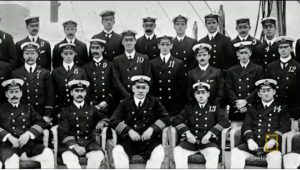 When we are going through things that others have gone through, it can be extremely helpful to listen to what they know. That advise is important for everyone, everywhere, because if we don’t listen and heed those warnings, we might just find ourselves learning a very hard lesson…that hindsight is always 20/20.
When we are going through things that others have gone through, it can be extremely helpful to listen to what they know. That advise is important for everyone, everywhere, because if we don’t listen and heed those warnings, we might just find ourselves learning a very hard lesson…that hindsight is always 20/20.
On April 14th, 1912, SS Mesaba, a ship on the same route as RMS Titanic had traveled through waters with dangerous icebergs floating around just a few hours before Titanic was to be there. The Mesaba sent out a warning about icebergs to every ship in the area, including 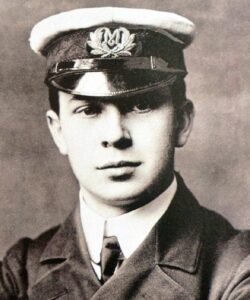 the Titanic. The message went out, and the crew of the Titanic received it, but the radio operator who received the message didn’t think it was important enough to deliver to the captain. This was probably because the Titanic’s radiomen were very busy. The passengers were sending and receiving messages with the mainland. It was a show of prestige. Even with the busy day, one would think that a message about an unusually high number of icebergs would have gone into the “high priority” pile, but of course hindsight is always 20/20. I’m sure that if John George Phillips, the Titanic’s senior wireless operator, had known then what he soon would know, he would have rushed the message to the captain immediately.
the Titanic. The message went out, and the crew of the Titanic received it, but the radio operator who received the message didn’t think it was important enough to deliver to the captain. This was probably because the Titanic’s radiomen were very busy. The passengers were sending and receiving messages with the mainland. It was a show of prestige. Even with the busy day, one would think that a message about an unusually high number of icebergs would have gone into the “high priority” pile, but of course hindsight is always 20/20. I’m sure that if John George Phillips, the Titanic’s senior wireless operator, had known then what he soon would know, he would have rushed the message to the captain immediately.
So many things would likely have been different, if people had only known what the future would bring. People wouldn’t have even been on the Titanic had they known. Then again, if the crew had known that an iceberg could do so much damage to an “unsinkable” ship, they would have listened when they were warned of very serious danger lurking in the waters ahead of them. They would have been crawling through the area, or they would have stopped for the night. They certainly wouldn’t have been pushing the ship to near maximum speed in an area of ocean that was filled with icebergs as dangerous as a floating mine or a torpedo. Unfortunately, hindsight is always 20/20, and the only reason we know the dangers now, is that the ship is at the bottom of 
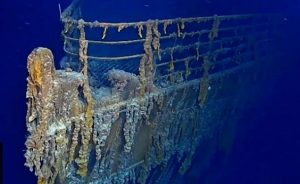 the ocean, having succumbed to the very fate everyone was so sure could never happen to the great Titanic.
the ocean, having succumbed to the very fate everyone was so sure could never happen to the great Titanic.
We can’t always know the dangers that lie ahead of us, but it is a wise man that pays attention to warnings of danger so that appropriate action can be taken. We can live with the saying, hindsight is always 20/20, or we can do our very best not to have to see that 20/20 hindsight with great regret.
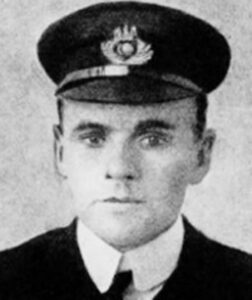 When RMS Titanic went down on April 15, 1912, after hitting an iceberg on April 14, 1912, it was a very different time than it is today. The sinking of a ship is a terrible tragedy, and often, there is so much panic. In 1912, there was a hard and fast rule in a shipwreck situation…women and children first. The only men allowed in the lifeboats were men needed as auxiliary seamen to man the lifeboats. Charles Herbert Lightoller was born March 30, 1874 into a family that had operated cotton-spinning mills in Lancashire since the late 18th century. His mother, Sarah Jane Lightoller (née Widdows), died of scarlet fever shortly after giving birth to him. His father, Frederick James Lightoller, emigrated to New Zealand when Charles was 10, leaving him in the care of extended family. Lightoller was a British Royal Navy officer and the second officer on board the RMS Titanic. He was also the most senior member of the crew to survive the Titanic disaster. Lightoller was the officer in charge of loading passengers into lifeboats on the port side. It was no easy task, because people were in a severe state of panic. Other seamen were launching lifeboats that were not filled to capacity, and since the ship did not have nearly enough lifeboats for all the people onboard. It is possible that orders that specifically said, “women and children only” may have been the reason so many lifeboats were launched before they were filled to capacity. I’m not sure if that is true or not, but if it was the case, it is a very sad revelation. It is also possible that as many as 400 more people could have been rescued, had the order been worded just slightly different. Nevertheless, Lightoller was following the orders as given to him, and not questioning the command.
When RMS Titanic went down on April 15, 1912, after hitting an iceberg on April 14, 1912, it was a very different time than it is today. The sinking of a ship is a terrible tragedy, and often, there is so much panic. In 1912, there was a hard and fast rule in a shipwreck situation…women and children first. The only men allowed in the lifeboats were men needed as auxiliary seamen to man the lifeboats. Charles Herbert Lightoller was born March 30, 1874 into a family that had operated cotton-spinning mills in Lancashire since the late 18th century. His mother, Sarah Jane Lightoller (née Widdows), died of scarlet fever shortly after giving birth to him. His father, Frederick James Lightoller, emigrated to New Zealand when Charles was 10, leaving him in the care of extended family. Lightoller was a British Royal Navy officer and the second officer on board the RMS Titanic. He was also the most senior member of the crew to survive the Titanic disaster. Lightoller was the officer in charge of loading passengers into lifeboats on the port side. It was no easy task, because people were in a severe state of panic. Other seamen were launching lifeboats that were not filled to capacity, and since the ship did not have nearly enough lifeboats for all the people onboard. It is possible that orders that specifically said, “women and children only” may have been the reason so many lifeboats were launched before they were filled to capacity. I’m not sure if that is true or not, but if it was the case, it is a very sad revelation. It is also possible that as many as 400 more people could have been rescued, had the order been worded just slightly different. Nevertheless, Lightoller was following the orders as given to him, and not questioning the command.
When all the lifeboats were launched, and the crew and remaining passengers knew the Titanic was surely going down, Lightoller and his fellow officers “all shook hands and said ‘Good-bye’” as they saw the last lifeboat off. Lightoller then dove into the frigid water from the bridge choosing to take his chances in the water, rather than the ship. Miraculously he managed to avoid being sucked down along with the massive ship. He clung to an nearby overturned lifeboat until the survivors were rescued. Lightoller was the last person pulled aboard the Carpathia and the highest-ranking officer to survive the wreck. One might imagine that surviving the greatest  maritime disaster of the 20th century would have made Charles Lightoller give up the sea forever, but he was not a man to let a little thing like having a ship ripped out from under him end his adventures at sea. No, he was not even close to being done with the sea.
maritime disaster of the 20th century would have made Charles Lightoller give up the sea forever, but he was not a man to let a little thing like having a ship ripped out from under him end his adventures at sea. No, he was not even close to being done with the sea.
Following his survival of the shipwreck of Titanic, Lightoller went on to serve as a commanding officer of the Royal Navy during World War I, Lightoller was given command of his own torpedo boat. He was decorated twice for gallantry for his actions in combat, including sinking the German submarine UB-110. He emerged from the Great War as a full naval Commander. Lightoller retired after the war, but couldn’t leave the sea behind entirely. He and his wife bought their own boat in 1929. They called it Sundower and spent the next decade cruising around northern Europe and carrying out the occasional secret surveillance mission for the Admiralty when the Germans began preparing for war again.
Though Lightoller was retired by the time World War II started, he provided and sailed as a volunteer on one of the “little ships” that played a part in the 1940 Dunkirk evacuation. Rather than allow his motoryacht to be requisitioned by the Admiralty, he and his son Roger and a young Sea Scout named Gerald Ashcroft, crossed the English Channel in Sundowner to assist in the Dunkirk evacuation. The boat was licensed to carry just 21 passengers, but Lightoller and his crew brought back 127 servicemen. On the return journey, Lightoller evaded gunfire from enemy aircraft, using a technique described to him by his youngest son, Herbert, who had joined the RAF and been killed earlier in the war. Gerald Ashcroft later described the incident, “We attracted the attention of a Stuka dive bomber. Commander Lightoller stood up in the bow and I stood alongside the wheelhouse. Commander Lightoller kept his eye on the Stuka till the last second – then he sang out to me “Hard a port!” and I sang out to Roger and we turned very sharply. The bomb landed on our starboard side.” So, years after his first lifesaving event, Lightoller was once again saving lives in an emergency. Many people 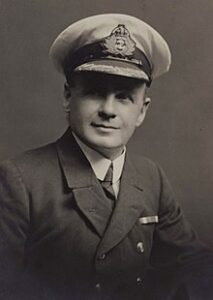 would be surprised to learn that he even had a yacht, but the sea was still a part of him. At the time of the evacuation Lightoller’s second son, Trevor was a serving Second Lieutenant with Bernard Montgomery’s 3rd Division, which had retreated towards Dunkirk. Unbeknownst to his dad, Trevor had already been evacuated 48 hours before Sundowner reached Dunkirk.
would be surprised to learn that he even had a yacht, but the sea was still a part of him. At the time of the evacuation Lightoller’s second son, Trevor was a serving Second Lieutenant with Bernard Montgomery’s 3rd Division, which had retreated towards Dunkirk. Unbeknownst to his dad, Trevor had already been evacuated 48 hours before Sundowner reached Dunkirk.
After the Second World War, Lightoller managed a small boatyard in Twickenham, West London, called Richmond Slipways, which built motor launches for the river police. Lightoller died of chronic heart disease on December 8, 1952, aged 78. He was a long-time pipe smoker, and he died during London’s Great Smog of 1952, which took the lives of many elderly people with breathing issues. His body was cremated, and his ashes were scattered at the Commonwealth “Garden of Remembrance” at Mortlake Crematorium in Richmond, Surrey.
 When a ship sinks, the first person to bring up an object from a wreck can claim legal ownership of the wreck under international maritime law. That gives that person the control of the wreck and control over salvage rights. Robert Ballard, one of the men who discovered the Titanic in 1985, had mixed feelings about disturbing the graves of those victims who are still there…a very noble man, if you ask me. Ballard’s partner, Jean-Lous Michel, agreed. They made the decision not to disturb the wreck, but rather to leave it in the pristine (for a wreck) condition that it was in. They didn’t bring up anything from the wreck.
When a ship sinks, the first person to bring up an object from a wreck can claim legal ownership of the wreck under international maritime law. That gives that person the control of the wreck and control over salvage rights. Robert Ballard, one of the men who discovered the Titanic in 1985, had mixed feelings about disturbing the graves of those victims who are still there…a very noble man, if you ask me. Ballard’s partner, Jean-Lous Michel, agreed. They made the decision not to disturb the wreck, but rather to leave it in the pristine (for a wreck) condition that it was in. They didn’t bring up anything from the wreck.
Unfortunately, their act of decency and kindness, left a legal door open, and that has been the greatest source of regret for the two men. Because they chose to bring nothing up from the wreck, they could not claim legal ownership of Titanic. Unfortunately, that left the ship vulnerable, because anyone and everyone now had a legal right for salvage the contents, and even parts of the ship…and they did. The artifacts and ship parts were free for the taking…and they were big business, especially after the movies came out, and interest grew. Soon, Titanic Ventures went in to claim salvage rights, and began bringing up artifacts to sell for exhibits and souvenirs. Since then, they have made a fortune on exhibits all over the world.

Following the find, and subsequent decision not to remove an artifact, anyone with the ability to explore the ocean floor that deep, went in and raided the ship. I’m sure that many of us have seen the Titanic exhibits, me included, and even purchased one of the artifacts, me included, but in my defense, I did not know the thoughts and wishes of Ballard and Michel, or the thoughts and feelings of the families of the deceased, at that time. I looked at the exhibit as a learning tool. I love learning, and I love history, and in fact, one of my own ancestors died on the Titanic, which I suppose gave me as much right to see the exhibit as anyone, but I’m still not sure it is right to make money off of the horrific way others lost their lives.
I remember as I went through the exhibit, walking through the recreation of the steerage rooms, with the eerie sounds of the water on the outside, thinking of the people who had been trapped there on that fateful night. I remember looking at the piece of the hull, thinking that I was standing almost close enough to reach out and touch part of a ship that had been so far under the ocean. I have seen both versions of the Titanic movies, but while looking at the exhibit, it was the original movie that came to my mind. Titanic wasn’t really a love story.  It was a loss story. It was a story of bravery, courage, and yes, love…the kind of love that made a wife refuse to leave her husband and parents to comfort their children, when all hope of survival was lost…holding in the tears of knowing that their children would never get to live their life to adulthood. When I think about all the lives that were lost on that fateful day, I can see how Ballard and Michel would want to leave the Titanic as it was, thereby preserving the graves of all those poor souls. While their idea was noble, it is sad that they didn’t bring at least one thing us so that their ownership and control could remain the gift they had planned to give the families.
It was a loss story. It was a story of bravery, courage, and yes, love…the kind of love that made a wife refuse to leave her husband and parents to comfort their children, when all hope of survival was lost…holding in the tears of knowing that their children would never get to live their life to adulthood. When I think about all the lives that were lost on that fateful day, I can see how Ballard and Michel would want to leave the Titanic as it was, thereby preserving the graves of all those poor souls. While their idea was noble, it is sad that they didn’t bring at least one thing us so that their ownership and control could remain the gift they had planned to give the families.
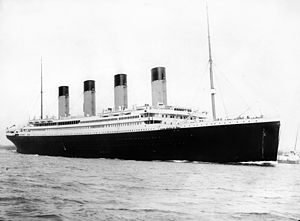 On September 1, 1985 a ship that had been missing in the North Atlantic since 1912…the RMS Titanic…was finally located, but the way in which it was found was not what it seemed to be. Everyone knows the story of Titanic, either from personal loss, history, or from recent movies on the subject, that romanticized it and endeared the ship to the world. The Titanic sank on April 15, 1912, after sailing headlong into an iceberg, while traveling at an unsafe speed, against protocol. The disaster took 1500 people to a watery grave, and changed the protocols concerning the radio room, speeds in iceberg prone areas, and radar to warn the ships about obstacles in the area.
On September 1, 1985 a ship that had been missing in the North Atlantic since 1912…the RMS Titanic…was finally located, but the way in which it was found was not what it seemed to be. Everyone knows the story of Titanic, either from personal loss, history, or from recent movies on the subject, that romanticized it and endeared the ship to the world. The Titanic sank on April 15, 1912, after sailing headlong into an iceberg, while traveling at an unsafe speed, against protocol. The disaster took 1500 people to a watery grave, and changed the protocols concerning the radio room, speeds in iceberg prone areas, and radar to warn the ships about obstacles in the area.
Oceanographer, Robert Ballard successfully found the Titanic while on a scientific mission for, of all people, the US Navy. The Navy had no interest in the Titanic, but Ballard had long wanted to find it, and he decided that the current mission would be the perfect chance to hunt for the Titanic, as well as the two submarines, USS Thresher and USS Scorpion, both of which had gone down in the North Atlantic and both of which were carrying powerful nuclear reactors. The Navy wanted to know if the Soviets had  shot down the submarined and if their nuclear material still remained 15,000 feet beneath the surface.
shot down the submarined and if their nuclear material still remained 15,000 feet beneath the surface.
Ballard asked the Navy to fund a project called Argo in the early 1980s. Argo was a submarine that could photograph the underwater to a depth of 20,000 feet. He wanted to find Titanic, but the Navy wanted to us the Argo to find the Thresher and the Scorpion. They agreed provided that he search for all three. In 1985 Ballard set out on a covert Cold War Mission, but publicly he was looking for Titanic. Ballard found the USS Scorpion, and then had just 12 days left to find Titanic. It was not going to be easy. Twelve days to find a ship that the French Research Institute couldn’t locate in five weeks.
While it seemed unlikely that the team would find the Titanic in the short amount of time they had left, their worry about the project’s success would prove unfounded. Around 2am on September 1, 1985, after over a week of taking pictures and finding nothing, the on-duty watch team called for Ballard. The Argo had spotted  something unusual on the seafloor. As the team peered at a grainy image before realizing that they were looking at the boiler from the Titanic. The team was ecstatic, as the popped champagne for a toast. Then they realized that it was almost the exact time that Titanic went down 73 years earlier. The team felt almost as if they were violating the sanctity of a grave, even if it was well below them. Ballard later wrote, “It was one thing to have won – to have found the ship. It was another thing to be there. That was the spooky part. I could see the Titanic as she slipped nose first into the glassy water. Around me were the ghostly shapes of the lifeboats and the piercing shouts and screams of people freezing to death in the water.”
something unusual on the seafloor. As the team peered at a grainy image before realizing that they were looking at the boiler from the Titanic. The team was ecstatic, as the popped champagne for a toast. Then they realized that it was almost the exact time that Titanic went down 73 years earlier. The team felt almost as if they were violating the sanctity of a grave, even if it was well below them. Ballard later wrote, “It was one thing to have won – to have found the ship. It was another thing to be there. That was the spooky part. I could see the Titanic as she slipped nose first into the glassy water. Around me were the ghostly shapes of the lifeboats and the piercing shouts and screams of people freezing to death in the water.”
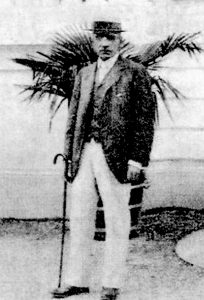 I’m not a superstitious person…don’t believe in that sort of thing, but I can a strange coincidence as clearly as the next guy. Ramon Artagaveytia was born July 14, 1840 in Montevideo, Uruguay, to Ramon and Maria Artagaveytia. December 24, 1871 found Artagaveytia sailing on the America, a ship out of Uruguay, when the boiler overheated and caught fire. The resulting catastrophic damage doomed the America to the ocean floor. Witnesses said that the America had been racing another ship into the port at Montevideo Harbor at a high rate of speed, and it is thought that the excessive boiler pressure caused it to catch fire.
I’m not a superstitious person…don’t believe in that sort of thing, but I can a strange coincidence as clearly as the next guy. Ramon Artagaveytia was born July 14, 1840 in Montevideo, Uruguay, to Ramon and Maria Artagaveytia. December 24, 1871 found Artagaveytia sailing on the America, a ship out of Uruguay, when the boiler overheated and caught fire. The resulting catastrophic damage doomed the America to the ocean floor. Witnesses said that the America had been racing another ship into the port at Montevideo Harbor at a high rate of speed, and it is thought that the excessive boiler pressure caused it to catch fire.
At the time of her sinking, America was carrying 114 first class, 29 second class, and 30 “popular” class passengers. I’m not sure what “popular” class, was, but I assume steerage. Of the 173 passengers, only 65 survived the sinking. Artagaveytia probably would not have been one of them, but he made a last ditch effort and jumped overboard and swam for his life. He recalled later that so many of the passengers were badly burned, and the ensuing nightmares Artagaveytia suffered, kept him too terrified to travel by ship for the next 40 years. That was particularly hard for Artagaveytia, who came from a family of sailors.
In 1905, Artagaveytia took over a farm in Garamini, Argentina. In 1912, Artagaveytia was still living in Argentina, but decided visit his nephew, who was the head of the Uruguayan Consulate in Berlin. Before returning home to Argentina, he decided to visit the United States, and it was that decision that sealed his fate. Artagaveytia told his cousin that he finally felt at ease about traveling on a ship. He thought he might even be able to sleep while on board, and not stand always at the rail wearing his life jacket. The thing that finally made him feel better about travel by ships was the wireless telegraph. He finally thought that someone would know  where these ships were, and that they could arrive quickly to help if needed. With that knowledge and the peace of mind it brought with it, Artagaveytia boarded the Titanic. Everyone knows the fate of the Titanic, and how so many mistakes were made…from sailing too fast, to ignoring the warnings, to turning off that all important radio. Ramon Artagaveytia had survived the sinking of the steamer America, but he would not make such an escape from Titanic. About a week after the disaster, his body was pulled from the North Atlantic. Once they were sure of his identity, he was returned to the Uruguayan Consul at Halifax. His body was forwarded to New York and then to Montevideo, Uruguay. He was buried in Cemeterio Central in Montevideo on June 18, 1912.
where these ships were, and that they could arrive quickly to help if needed. With that knowledge and the peace of mind it brought with it, Artagaveytia boarded the Titanic. Everyone knows the fate of the Titanic, and how so many mistakes were made…from sailing too fast, to ignoring the warnings, to turning off that all important radio. Ramon Artagaveytia had survived the sinking of the steamer America, but he would not make such an escape from Titanic. About a week after the disaster, his body was pulled from the North Atlantic. Once they were sure of his identity, he was returned to the Uruguayan Consul at Halifax. His body was forwarded to New York and then to Montevideo, Uruguay. He was buried in Cemeterio Central in Montevideo on June 18, 1912.
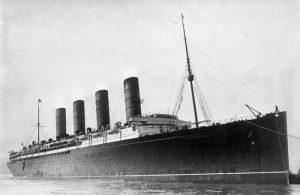 Most people have heard of the Titanic sinking, and how disaster could have been prevented, had they just slowed down, listened to the warnings, and had they had enough lifeboats. There is, however, another ship sinking that not so many people have heard of, or if they had, they didn’t pay much attention to. It is the Lusitania. Like the Titanic, the sinking of the Lusitania could have been prevented too, had a number of simple precautions been taken, such as not to sail at all that fateful May day in 1915.
Most people have heard of the Titanic sinking, and how disaster could have been prevented, had they just slowed down, listened to the warnings, and had they had enough lifeboats. There is, however, another ship sinking that not so many people have heard of, or if they had, they didn’t pay much attention to. It is the Lusitania. Like the Titanic, the sinking of the Lusitania could have been prevented too, had a number of simple precautions been taken, such as not to sail at all that fateful May day in 1915.
RMS Lusitania left New York for Britain on May 1, 1915, unfortunately during a time when German submarine warfare was intensifying in the Atlantic. On February 4, 1915, Germany had declared the seas around the United Kingdom a war zone, and the German embassy in the United States had placed newspaper advertisements warning people of the dangers of sailing on Lusitania. Not to defend the Germans, but they had warned people that they would attack all ships, military or passenger. Unfortunately, not many people boarding Lusitania that morning had time to read the paper before embarking on their journey. It amazes me that it was left to the people, who were told that the ship could outrun the German U-boats. They were also told that they 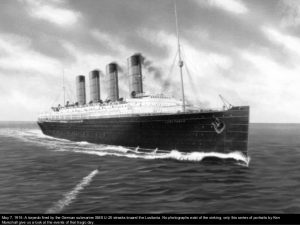 would have escort ships as they entered the war zone. And, they were told that the U-boats were not attacking neutral passenger liners. Unfortunately, these things were not factual. Part of the problem was that the Allies had begun disguising war ships as passenger ships on the assumption that the Germans would not attack passenger ships. Other passenger ships were actually used to transport soldiers and ammunition, or even just ammunition, in the thought that they would be safe from harm that way. The Allies were also supposed to have escort ships to take the passenger ships, but that did not happen in the case of the Lusitania.
would have escort ships as they entered the war zone. And, they were told that the U-boats were not attacking neutral passenger liners. Unfortunately, these things were not factual. Part of the problem was that the Allies had begun disguising war ships as passenger ships on the assumption that the Germans would not attack passenger ships. Other passenger ships were actually used to transport soldiers and ammunition, or even just ammunition, in the thought that they would be safe from harm that way. The Allies were also supposed to have escort ships to take the passenger ships, but that did not happen in the case of the Lusitania.
The sinking of the Cunard ocean liner RMS Lusitania occurred on Friday, May 7, 1915 during the First World War, as Germany waged submarine warfare against the United Kingdom which had implemented a naval blockade of Germany. The ship was identified and torpedoed by the German U-boat U-20 and sank in just 18 minutes, and also took on a heavy starboard list. The Lusitania went down 11 miles off the Old Head of Kinsale,  Ireland, killing 1,198 and leaving 761 survivors. The sinking turned public opinion in many countries against Germany, and it was a key element in the American entry into World War I. The torpedoing and subsequent sinking became an iconic symbol in military recruiting campaigns. The injustice of it brought about the outrage that would likely cause soldiers to enlist. Still, the United States did not immediately enter into the war. The American government first issued a severe protest to Germany…a waste of time really. Then, following immense pressure from the United States and recognizing the limited effectiveness of the policy, Germany abandoned unrestricted submarine warfare in September 1915.
Ireland, killing 1,198 and leaving 761 survivors. The sinking turned public opinion in many countries against Germany, and it was a key element in the American entry into World War I. The torpedoing and subsequent sinking became an iconic symbol in military recruiting campaigns. The injustice of it brought about the outrage that would likely cause soldiers to enlist. Still, the United States did not immediately enter into the war. The American government first issued a severe protest to Germany…a waste of time really. Then, following immense pressure from the United States and recognizing the limited effectiveness of the policy, Germany abandoned unrestricted submarine warfare in September 1915.
 Some historic events seem to continue to intrigue us, many years after the event took place. The RMS Titanic was one of those events. The Titanic sank on its maiden voyage on April 15, 1912…as we all know, considering the movies that have been made detailing and even romanticizing the tragedy. Of course, the way that so many people lost their lives that night is something that many people have wondered about all these years. Musicians who played well into the disaster, in an effort to keep people calm, the many men who died because they did the honorable thing and allowed the women and children to be saved first, and the women who would not leave without their husbands…all of these gave us a glimpse of a time when people did the right thing no matter the cost.
Some historic events seem to continue to intrigue us, many years after the event took place. The RMS Titanic was one of those events. The Titanic sank on its maiden voyage on April 15, 1912…as we all know, considering the movies that have been made detailing and even romanticizing the tragedy. Of course, the way that so many people lost their lives that night is something that many people have wondered about all these years. Musicians who played well into the disaster, in an effort to keep people calm, the many men who died because they did the honorable thing and allowed the women and children to be saved first, and the women who would not leave without their husbands…all of these gave us a glimpse of a time when people did the right thing no matter the cost.  There are precious few of those kinds of people around these days.
There are precious few of those kinds of people around these days.
With all the interest concerning the Titanic, an idea occurred to someone, that maybe there should be a duplicate Titanic…a way to return her to her former glory, even if it is only a duplicate. The new ship is supposed to be an identical copy of the infamous ocean liner, which sank in 1912 following a collision with an iceberg. However, to avoid a repeat disaster, Titanic II will be outfitted with plenty of life boats, and will have a welded, not riveted hull, plus modern navigation and radar equipment.
The project initiated by Australian businessman and politician Clive Palmer, has not always been smooth sailing,  however. The project was announced in April 2012, which was 100 years after the original Titanic sank. The plan was that Titanic II would be the flagship of the proposed cruise company Blue Star Line of Brisbane, Australia. At that time, they intended to launch the Titanic II in 2016. The project was delayed until 2018, and then to an expected 2022 date, but with the 2020 Coronavirus worldwide shutdown, I wonder if that date will also have to be moved back.
however. The project was announced in April 2012, which was 100 years after the original Titanic sank. The plan was that Titanic II would be the flagship of the proposed cruise company Blue Star Line of Brisbane, Australia. At that time, they intended to launch the Titanic II in 2016. The project was delayed until 2018, and then to an expected 2022 date, but with the 2020 Coronavirus worldwide shutdown, I wonder if that date will also have to be moved back.
“The ship will follow the original journey, carrying passengers from Southampton to New York, but she will also circumnavigate the globe, inspiring and enchanting people while attracting unrivaled attention, intrigue and mystery in every port she visits,” said Palmer in a statement. The planned maiden voyage will take passengers from Dubai to New York, however, reports CruiseArabia, with the first sailing scheduled to take place in 2022. It’s possible for this maiden voyage to happen, but it will take a few less problems going forward.

